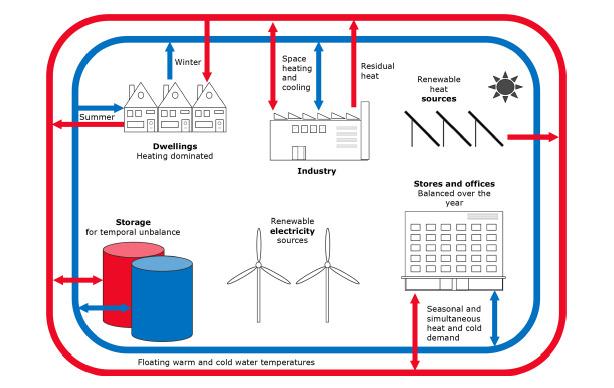District Heating and Cooling – A Key Element of Energy System Integration
D2Grids Project

Energy System Integration is a key initiative of the Green Deal, highlighted in the new European Commission Strategy on Energy System Integration. Read more about the important role of district heating and cooling in this initiative, and how the strategy can impact DHC developments.
To take on the climate and energy challenge and make the transition happen, the energy system of the future will have to be efficient, green, decentralized and integrated on various levels. The integration of a high share of variable renewables will entail a lot more flexibility to ensure the stability and reliability of the grids. Exploiting the synergies between technologies, energy carriers, storage, infrastructures and sectors will be instrumental in achieving this flexibility. Therefore, sector integration represents the quickest and most efficient path to decarbonisation.
In her mission letter to the incoming Energy Commissioner Kadri Simson, President-Elect Ursula von der Leyen instructed Simson to “explore ways to facilitate the smart integration of the electricity, heating, transport and industry sectors as a means to speed up the deployment of clean energy across the economy”. For this reason sector integration was poised to be a key element of the Green Deal.
When taking the whole energy system into account, thermal networks can enable more flexibility and storage capacity in a future energy system. The roll-out of existing technologies and solutions; such as thermal storage, heat pumps and district heating and cooling (DHC); can play an important role in the wider energy transition, linking together parts of the system that have traditionally been isolated from each other. For instance, coupled with large heat pumps, DHC networks can absorb large amounts of renewable electricity, providing cost-efficient balancing and storage to the grid. Heat networks can also connect nearby buildings with waste heat and cold sources from industrial and commercial sources.
What is “energy system integration”?
Energy system integration means linking the various energy carriers and storage solutions with each other and with the end-use sectors for a robust, reliable, efficient energy system. This includes local carriers and storage solutions (heating, cooling, and local transport) as well as cross-border infrastructures (e.g. electricity, gas and transport).
2020 Strategy on Energy System Integration
In the summer of 2020, the European Commission published the long-awaited Strategy on Energy System Integration. The strategy aims to set out a vision of how to accelerate the transition towards a more integrated energy system, supporting decarbonisation across sectors while promoting growth and technological innovation.
The document recognises the role of district heating and cooling in achieving these objectives. It underlines both (A) the considerable potential of local energy networks to contribute to the European energy transition and (B) the need for legislative incentives and financial support in order to ensure that this potential is transformed into reality. In addition, it contains elements with direct impact for DHC developments:
- Waste heat. The strategy highlights the need to make more use of waste heat from industrial sites, data centres and other sources via DHC networks. It anticipates new enabling measures as part of the revision of the Renewable Energy Directive and the Energy Efficiency Directive (both expected in June 2021).
- DHC networks as enabling infrastructure for a smart energy system. Very much in the spirit of Heat Roadmap Europe, the paper makes numerous references to the ability of DHC to contribute to the development of a smarter and more flexible energy system, especially through its interaction with the electricity and gas grids. This concept helps to establish DHC as not only a local heat supply solution but a strategic asset for Europe as a whole.
- Taxation and state aid. The text refers explicitly to the lack of a level playing field regarding the internalisation of CO2 costs in the heating sector, and identifies the extension of the ETS and a revision of the Energy Taxation Directive as possible remedies. The prominence of DHC in the Commission’s vision for an integrated energy system will strengthen the sector’s arguments during the debate on the revision of the State aid framework in 2021.
The Strategy on Energy System Integration is a positive step towards re-confirming the vital role of DHC networks in modern and decarbonised energy systems. In the second half of 2020, the strategy will be discussed by the Council and the European Parliament, with a view to future concrete legislative and non-legislative actions.
- Stef Boesten, Wilfried Ivens, Stefan C. Dekker, Herman Eijdems: 5th generation district heating and cooling systems as a solution for renewable urban thermal energy supply. Adv. Geosci., 49, 129–136, 2019
Article first published in Celsius, learn more.



